A cultural movement is in full bloom at Punahou. It is expansive, it is dynamic – and it is unabashedly green.
Wherever you look, there are signs that sustainability has fully taken root, and with it an awareness that Hawai‘i and, indeed, the world’s natural resources are finite and must be managed with care.
To be clear, Punahou’s connection to the environment is not new, after all its campus was once home to a working farm. Over the years, there have been numerous initiatives and investments launched in the name of sustainability. What feels different today is the central role that sustainability now plays in the strategic planning of the School and, most importantly, in the culture of its people.
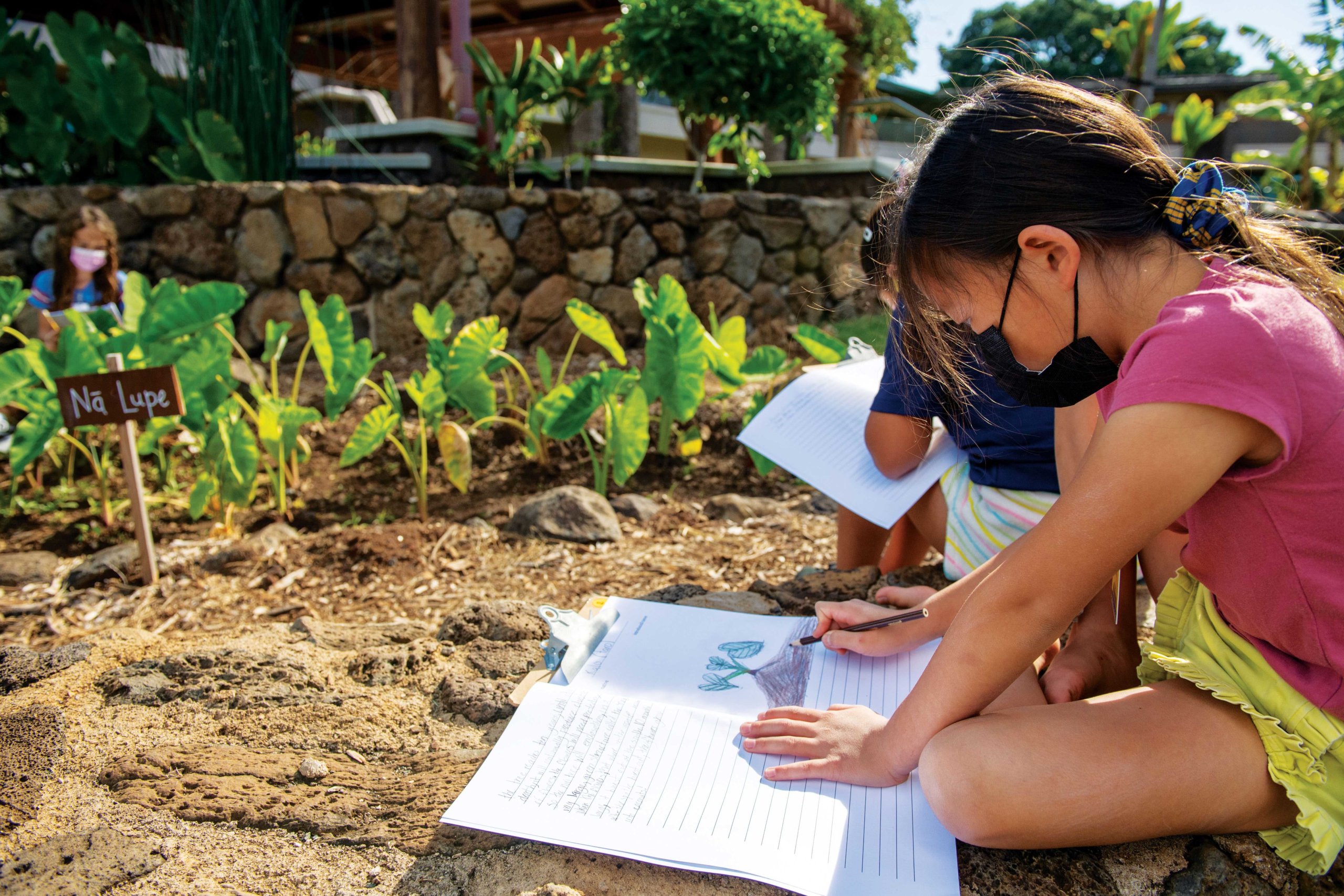
“Twenty years ago, sustainability was a popular buzzword,” says Ke‘alohi Reppun ’99, director of the Kuaihelani Center for ‘Ike Hawai‘i. “It was a trendy term, but people didn’t always follow through with what it really meant in practice.” Reppun now sees a critical number of faculty and staff on campus whose identities are intertwined with sustainability inside and outside of the classroom. “For them, sustainability isn’t just a concept to teach in school, it is also a part of who they are – it’s personal.”
Students are also a driving force behind this movement, and they are ready for real progress. “Kids look first within Punahou for solutions to sustainability problems,” says Dani Goddard, director of Luke Center for Public Service. “When they see strong examples within the School, they feel empowered to go out into the world and make a difference.”
Our alumni are heeding the call as well. “Sustainability and the state of our planet weigh on the minds of the entire Punahou community – from our students to our alumni. We’re seeing a groundswell, which is good because it is going to take everyone to tackle this issue,” says Noelehua Lyons ’91 Archambault, vice president for InstitutionaI Advancement. “The cost of inaction is simply too high.”
The groundswell can be felt everywhere. Spend a day walking around Punahou’s 76-acre campus and you are likely to see Junior School students growing herbs and vegetables under the guidance of Eliza Leineweber ’92 Lathrop or learning about the water cycle by working in a kalo patch with Kumu Andy Nelson and Kumu Shelby Ho ’01. Go up to Pu‘u o Mānoa (Rocky Hill), and you may find Academy students building a windmill to generate electricity or documenting the native plants that grow there. Then there are the newly installed electric vehicle chargers in the Sullivan parking lot, composting operations, photovoltaic panels and the overall environmentally conscious design in many of the buildings around campus.
This edition of the Punahou Bulletin highlights some of the individuals who are helping to promote a culture of sustainability at the School and beyond. Their stories are part of a richly diverse mosaic of activities and aspirations that are springing to life at Punahou – from its teaching kitchens to its tennis courts; from its sustainability fair to its fabrication labs. They also serve as a powerful reminder of how people, through passion and creativity, can work together to make meaningful and enduring change.
– By Gina Gelber
Sustainability in Action



Nestled atop Punahou’s verdant campus is a piece of land that plays a critical role in Punahou’s quest for a sustainable future: Pu‘u o Mānoa, a place of history and cultural significance known to many as Rocky Hill. It is also the backdrop where Kumu Andy Nelson and Kumu Shelby Ho ’01, stewards of Punahou’s Outdoor Education program, have created countless memorable outdoor experiences for students, such as camping, caring for animals and identifying stars.
“One of the goals of our program is equipping and empowering students to take care of the natural world,” says Nelson, Outdoor Education coordinator. “These activities are a tremendous opportunity to not just talk about stewardship but to let students get their hands dirty and see how good it feels to take care of our environment.”
To advance this goal, Nelson and Ho joined forces with a group of Academy students to create the Rocky Hill Conservation Corps (RHCC). Launched in the fall, RHCC was inspired by Franklin D. Roosevelt’s Civilian Conservation Corps to drive young people to care for the land, parks and public spaces. Each Friday, after a long week of school and extracurricular activities, young stewards make the trek up the hill to volunteer, explains Ho, assistant Outdoor Education coordinator.
Activities can vary from weeding invasive species to planting native plants; there is no shortage of work. The RHCC is open to all who are interested, no experience needed, and hopes to grow to include more faculty, alumni and retirees in the future.
Providing opportunities for students to take genuine action can hopefully inspire them to continue on this path upon graduating Punahou, says Nelson – whether it is in environmental law, becoming a park ranger, or making daily decisions that positively impact their environment and community. The hope for Nelson and Ho is for students to see the power of collective action and to continue to care for and protect our planet.
Launching the RHCC initiative was also important for Nelson and Ho because they wanted to honor the work of their predecessors, Gail Peiterson, Dave White and Tai Crouch. “They cared deeply about students and this sacred part of campus and valley,” says Nelson. “We remember not only the time and energy they put into this place, but the tone of their voice, their strong belief in students, and the trust and patience they showed to others wanting to learn. This place was special to them.”
Some of the attractions that can be seen from this 280-foot vantage point include a view of the campus, outdoor learning spaces, a World War II bunker, the propagation and outplanting of native plants, the occasional owl, a few sheep, and kids gaining a genuine connection to their environment.
And while this place offers the best views of the valley, the best views may actually be inward, says Ho. “Kids won’t be motivated to care for what they don’t know or don’t feel a strong connection to,” she notes. “The mo‘olelo of this part of Mānoa, it encompasses the power of the past and the potential of the future.”
– By Gina Gelber
Grounded in Green
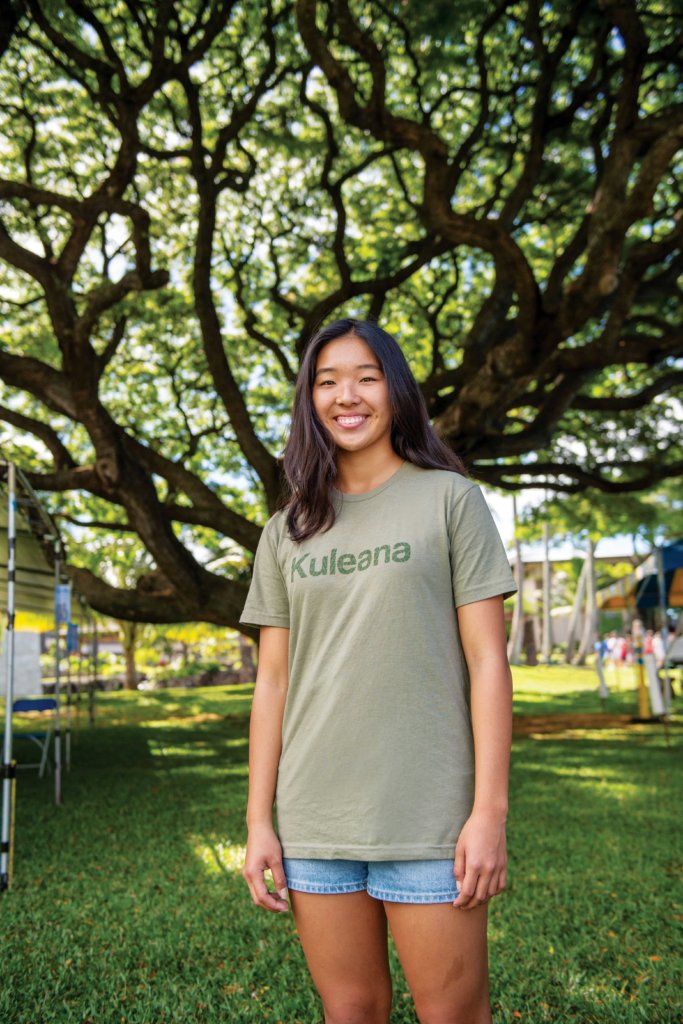
Getting the next generation excited about sustainability is all in a day’s work for Kaelah Kimura ’23. A champion for leadership and environmental stewardship, Kimura hopes to make a difference by leading workshops for aspiring environmental leaders and being one of the lead coordinators at the student-run Sustainability Fair in April.
Kimura’s roots in sustainability run deep. Being a student in the inaugural class of the Omidyar K – 1 Neighborhood and now a junior in the Academy, she has seen the campus evolve over the years. Early on, she remembers marveling at the campus’s ‘auwai, where rock ditches built into the landscape channel rainwater to feed surrounding plants and trees. “It really showed the interconnectedness between people and environment and inspired lots of conversations in school from a young age,” Kimura says.
Kimura is hoping to instill the same sense of wonder about the planet in the next generation at Punahou. Together with fellow classmates, Kimura has developed an ever-evolving curriculum of workshops for students in grades 3 – 5. The workshops and classes have reached over 100 students and focus on sustainability through games, leadership-building activities, environmental design challenges, and highlight such young environmental leaders as Swedish climate activist, Greta Thunberg.
To expand outreach beyond the classroom, Kimura was one of eight Academy student leaders behind the Sustainability Fair. Since 2006, the fair has been a staple at Punahou, promoting environmental sustainability and conservation. Student leaders collaborate closely with Luke Center staff to design, coordinate and run the event, sharing their passion about caring for the earth and also gaining valuable skills in planning, communication and management. For two years during the pandemic, the fair took place virtually.
Brimming with activities, the fair hosted Punahou students from all grades who visited booths to learn about environmental initiatives from such nonprofits as Hawaii Audubon Society, Sierra Club, Nā Kama Kai and Blue Planet Foundation. Academy students presented sustainable projects they’ve been working on, including designing and building a community fridge for the public to use and turning plastic beach trash into jewelry.
Attendees played games and made crafts from reclaimed materials, such as headbands from old t-shirts. Punahou’s solar-powered electric train, built by students at the D. Kenneth Richardson ’48 Learning Lab, was set up as a demonstration on renewable energy. In Cooke Library, Academy students also hosted a clothing swap to promote the reuse of household items.
Through the workshops and the fair, Kimura’s intention is for students to get a taste of what sustainability is all about and get excited about environmental issues, hopefully taking an interest in advocacy as she has. It is a lesson that continuously gets reinforced in Kimura’s home – giving back to Hawai‘i and honoring Hawaiian values that prioritize sustainability and caring for finite resources.
With father Stan, a captain in the fire department, mother Shelee Kimura, president and CEO of Hawaiian Electric, and brother Brennan and sister Sarah, both into environmental science and policies, Kimura says a love for the environment is a big part of the family’s culture.
“I credit my interest in the environment to both of my parents because my dad and my mom together really gave us the foundation growing up. We went surfing all the time, hiking and camping,” she says. The family bonds over volunteer days with ocean conservation nonprofit Nā Kama Kai, for example.
“Climate change is really the fight of our generation and the ones after us,” Kimura says. “There need to be more leaders and sustainability in order to accomplish and solve the problems that we’re being faced with right now. So, we’re hoping to spark an interest in the environment that can continue as these students grow older.”
– By Rachel Breitweser ’03

Food for Thought
Food brings people together in ways that not many things can. “I don’t get so excited about PV panels, but I do get excited about food,” says Eliza Leineweber ’92 Lathrop, Punahou’s garden resource teacher.
She and like-minded gastronomy instructors on campus who are passionate about food sustainability are giving rise to a school-to-table education that enables students to connect the dots between where food is sourced and how it makes its way onto their dinner plates.
“You can’t just talk about food or about ingredients – you have to talk about the sourcing, the farm practices, how you’re preparing it, and what happens to the waste. It’s a question of in what ways are you ready to bring that food to its fullest potential?” says Lathrop.
The gardens on campus are a big part of that. You wouldn’t know it from looking at its façade but tucked behind the Academy’s Griffiths Hall is a greenspace bursting with fruits, herbs and vegetables. It is one of several flourishing gardens across campus tended by students and teachers.
Trislyn Tom ’00 Ferris, a culinary arts faculty member within the Design Technology and Engineering Department, often invites her middle school students to pick herbs from the garden in Bishop Hall to add a creative flare to their dishes.
For his part, Mark Noguchi ’93 – Punahou’s food curriculum specialist, culinary chemistry teacher and resident chef – can be seen with a long-handled trimmer and groups of Junior School students on their way to harvest ulu from the campus’s trees, which Academy students then use in their cooking class. If he has his way, the ‘ulu will get a lot more play as he is working on a pilot project to use the plant in preparing snacks for kids in After School Care.
Lathrop’s students delight in growing and picking a range of unique vegetables, like “cosmic purple” carrots with violet skin and orange interiors and “dragon tongue beans” that are anything but green. This is all part of building a literacy around food that starts with an understanding of where and how food is grown. As Noguchi says, “If you understand where your food comes from, you come away with a stronger respect for food and you have a stronger respect for the ‘āina.”
From there, educators take students into the classroom kitchens to taste ingredients and learn how to incorporate them in recipes. “I’m passionate about food education because it engages on so many different levels – the joy that cooking brings, how excited students are to taste things for the first time, and that they can take their knowledge and share it with their families,” says Ferris. One of her students now makes fresh summer rolls for her family every week after learning the technique, which uses fresh mint and herbs from the garden.
The newly remodeled kitchen Ferris helped design and set up in Bishop Hall, the kitchen in the Sidney and Minnie Kosasa Community for Grades 2 – 5, and the plans for the new food design lab in the upcoming remodel of Cooke Library are examples of how Punahou is expanding its culinary arts program. Lathrop, Ferris and Noguchi look forward to continuing to spread their roots through more collaborations, on and off campus. Noguchi, for one, is in talks with Roosevelt High School’s leadership about the potential of hosting students for culinary workshops, as part of Punahou’s mission as a private school with a public service.
“We have the incredible potential to be a leader in Hawai‘i,” says Lathrop, who sites the Edible Schoolyard Project founded by Berkeley locavore chef Alice Waters as a great example of potential opportunities, where gardens, kitchens and even the campus cafeteria are connected as educational spaces. “As food activist Michael Pollan wrote, we eat three times a day, so we are making choices that really impact our health and the health of our planet every single day,” she says. “If we thought about making different kinds of choices with any one of those little moments, what an impact that would have. If you take the population of this school, and you think about how many people interact with food, if we did that, even a little bit better, it would be huge.”
– By Rachel Breitweser ’03
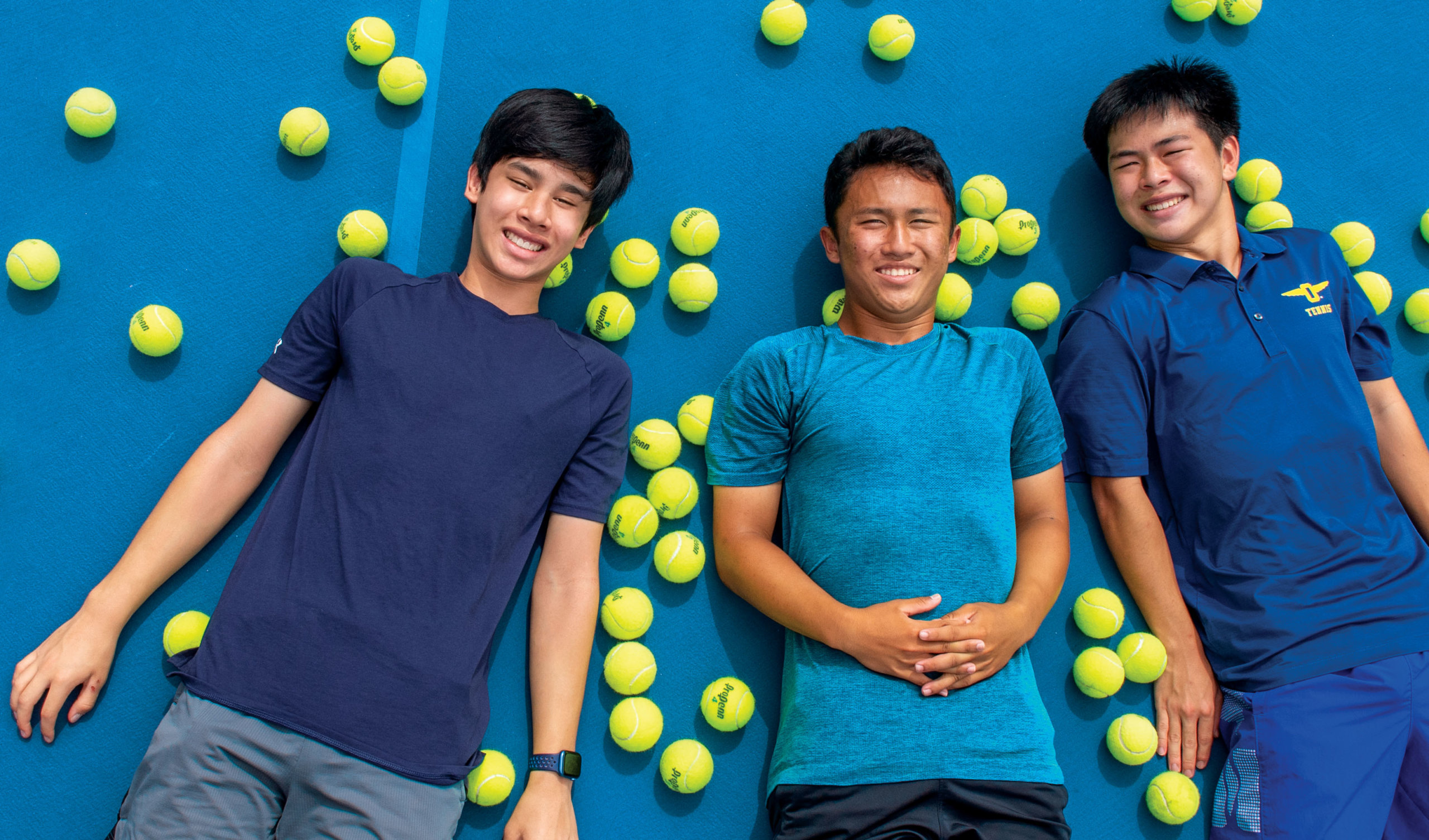
Game Changers
From left to right: David Samtani ’24, Payton Jim On ’24 and Koko Leong ’24.
Koko Leong ’24 and David Samtani ’24 decided to take action when they began learning about the detrimental impact that tennis has on our environment – like the fact that 125 million tennis balls end up in America’s landfills and that it takes about 400 years for a tennis ball to decompose.
“We had played tennis our entire lives and never really considered the impact of tennis balls – the amount of waste caused is huge,” says Leong, especially considering most balls are used only 16 times before they are tossed.
To tackle this problem, the Punahou Junior Varsity tennis players and Luke Leaders within the Luke Center for Public Service, teamed up with Payton Jim On ’24, Varsity tennis player and assistant Junior Varsity coach, in 2021. Other tennis players, Logan Tom ’25, Sophia Howell ’26 and Spencer Yamamoto, a student at ‘Iolani, also joined their efforts.
Since their sophomore year, they have collected about 300 balls every three weeks from local schools and clubs. They gather the balls, box them up and ship them to the nonprofit RecycleBalls, which repurposes the rubber into tennis courts, playgrounds and turf, and reuses the fuzzy outer layer for new balls sold by Wilson Sporting Goods.
So far, the tennis players have collected about 1,500 balls from Punahou, ‘Iolani, Mid-Pacific, Kamehameha and Kailua Racquet Club. Next year, they plan to expand to Hawai‘i Pacific University, University of Hawai‘i at Mānoa and private clubs, with the hope of collecting upwards of 4,000 balls.
Coming together for the greater good of helping the environment has been a rewarding opportunity to foster teamwork and a sense of community among the tennis players, qualities that are sometimes lacking among ultra-competitive athletes.
“I feel proud that this project is helping people learn to work together more instead of it being everyone for themselves, and I like seeing tennis players being able to have relationships with each other,” says Jim On, who won the 2022 ILH Singles and HHSAA State Singles Championships for boys singles tennis and has represented Hawai‘i at the national level.
Leong agrees, “It feels amazing to be part of something that’s community-centered and environmentally driven and to see boys, girls and players from different grades and schools coming together to put the interest of the community ahead of themselves.”
The players plan to hand their work off to the next generation of tennis players at Punahou so that the project can live on after they graduate. “Sustainability isn’t ever done. It doesn’t end,” said Leong, who notes he has been inspired to give back to the planet ever since working in the gardens as a kindergartner at Punahou.
“We’re just a small stepping stone, a tiny rock in the middle of the ocean, starting something small in Hawai‘i,” says Jim On. “There are huge factories out there that contribute to pollution on a global scale, but hopefully people can use our project as an example.” And if it can bring tennis players together, it’s a true win-win for everyone.
– By Rachel Breitweser ’03
Hands-on Solutions
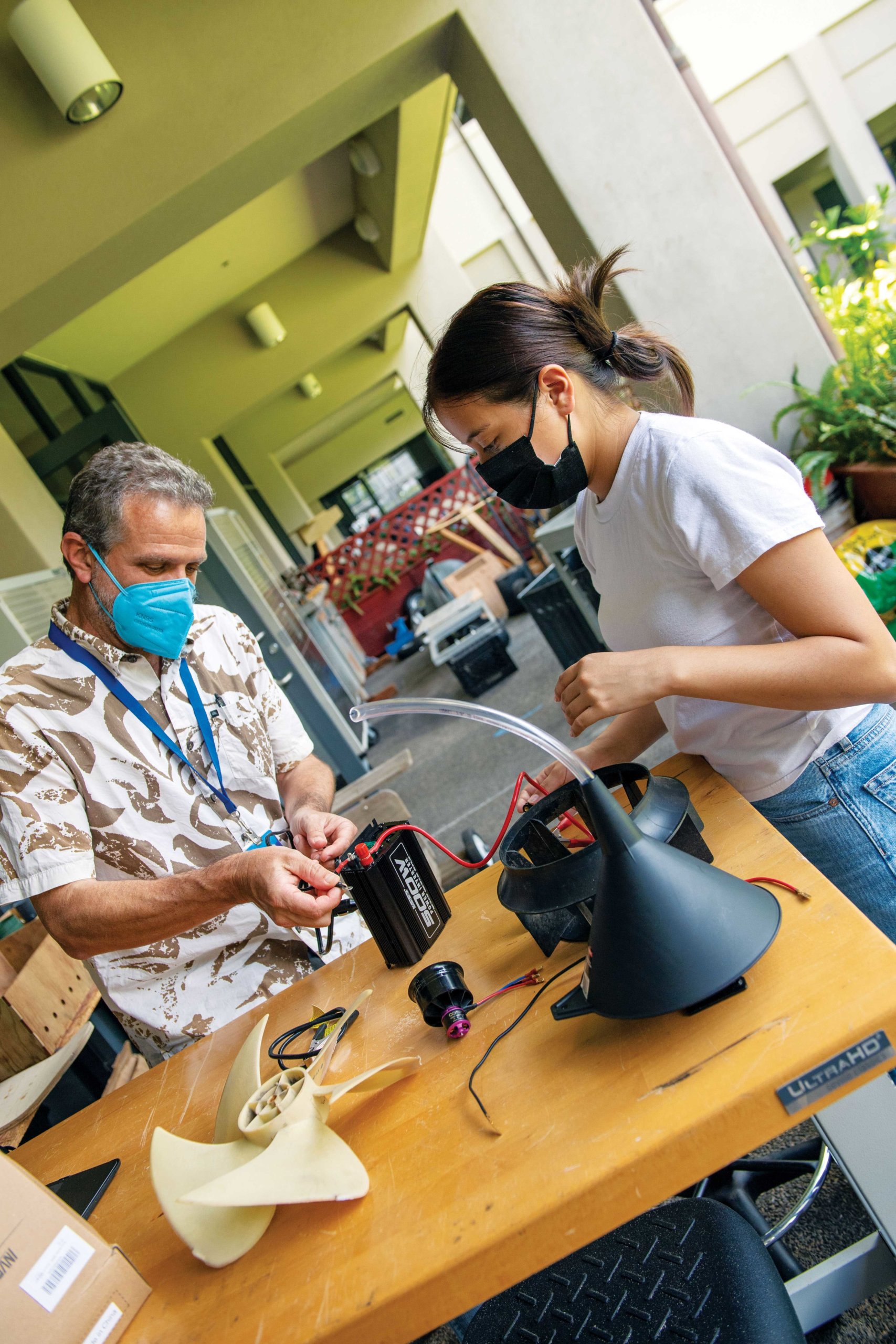
Throughout his years as Academy faculty, Ian Earle ’89 has taken note of a powerful refrain in the buff ’n blue community: A desire to help our environment. With this in mind, he helped to design and launch Environmental Problem Solving – a project-based course that enables students to identify and analyze complex real-world environmental issues with the endgame of ideating and presenting potential solutions.
“The students who come into the class understand the big picture that our world is in trouble, and they want to do something about it,” Earle says. “They want to feel useful. They want to make a difference. And so, this class provides a venue for taking action.”
The course, introduced in 2018, has student-based projects which span from a device that makes seawater drinkable to a three-way renewable energy generator that runs on wind, solar and water. Earle lets students take the lead in their learning – whether it is exploring the physics of creating electricity or understanding how a power tower works – and helps connect them with other teachers or students for outside advice and expertise. Regardless of whether students end up with a working prototype at the end of the interdisciplinary class, it’s the learning journey they take that’s most impactful, Earle explains.
Take Kate Ellis ’22. Driven by the desire to preserve earth’s beauty for future generations, Ellis is conceptualizing a hydro, wind and solar-powered generator, which she envisions as a portable device that can be deployed after a natural disaster to regain electricity. The generator could be set up in a river, for example, to produce electricity simultaneously from the different renewable energy sources. Other student projects include a prototype of a design for a desalination plant, designed by Nathan Rath ’23, and a concept for an aluminum toothbrush – made from melted cans – that could replace plastics ones.
Earle, who also teaches Spanish, social studies and anthropology in the Academy, weaves sustainability into all of his lessons, regardless of the subject. He has been an instrumental champion of sustainability at Punahou, serving as Punahou’s Path to Net Zero fellow, where he partnered with Physical Plant leadership to reduce energy use on campus and developed education around sustainability for students of all ages. He is also advisor to the Academy’s Sustainable Living Club, which hosts beach clean-ups, plants trees and more.
He says his personal “a-ha” moment about the state of the environment took place while studying green sea turtle migration on Midway Atoll with students from Hawai‘i Preparatory Academy. The date happened to be Sept. 11, 2001. “Walking on the beach, I was like, holy smokes, there is so much trash. Then coming back to Hawai‘i, I noticed the plastic accumulation on the beach. Once you see it, you can’t stop seeing it. Ever since then, it’s been on the forefront of my mind that we’re throwing the planet out of whack and that it’s worse than we think. It’s hard for humans in their day-to-day lives to understand.”
Now Earle is rewarded by watching students’ passions flourish as they join forces and create a community of like-minded students concerned about the environment. And he takes part, too, once joining students as they avoided animal products for a month and went vegan, a diet shown to be more sustainable for the environment.
He’s heartened by the students’ response. “They never think that just because they’re teenagers, they can’t make a difference,” Earle said. “They also know they’re the generation that’s going to have to solve this, and they feel the weight of the world is on their shoulders.”
Fortunately, with inspiration from teen activist Greta Thunberg, the youth movement is gaining traction. “Adults listen more to the youth,” Earle said. “If it was me protesting, not so much, but when you get a kid doing it, people start to take notice, and I hope this class gives them a voice.”
– By Rachel Breitweser ’03
Mālama ‘Āina:
An Alumna’s Imperative
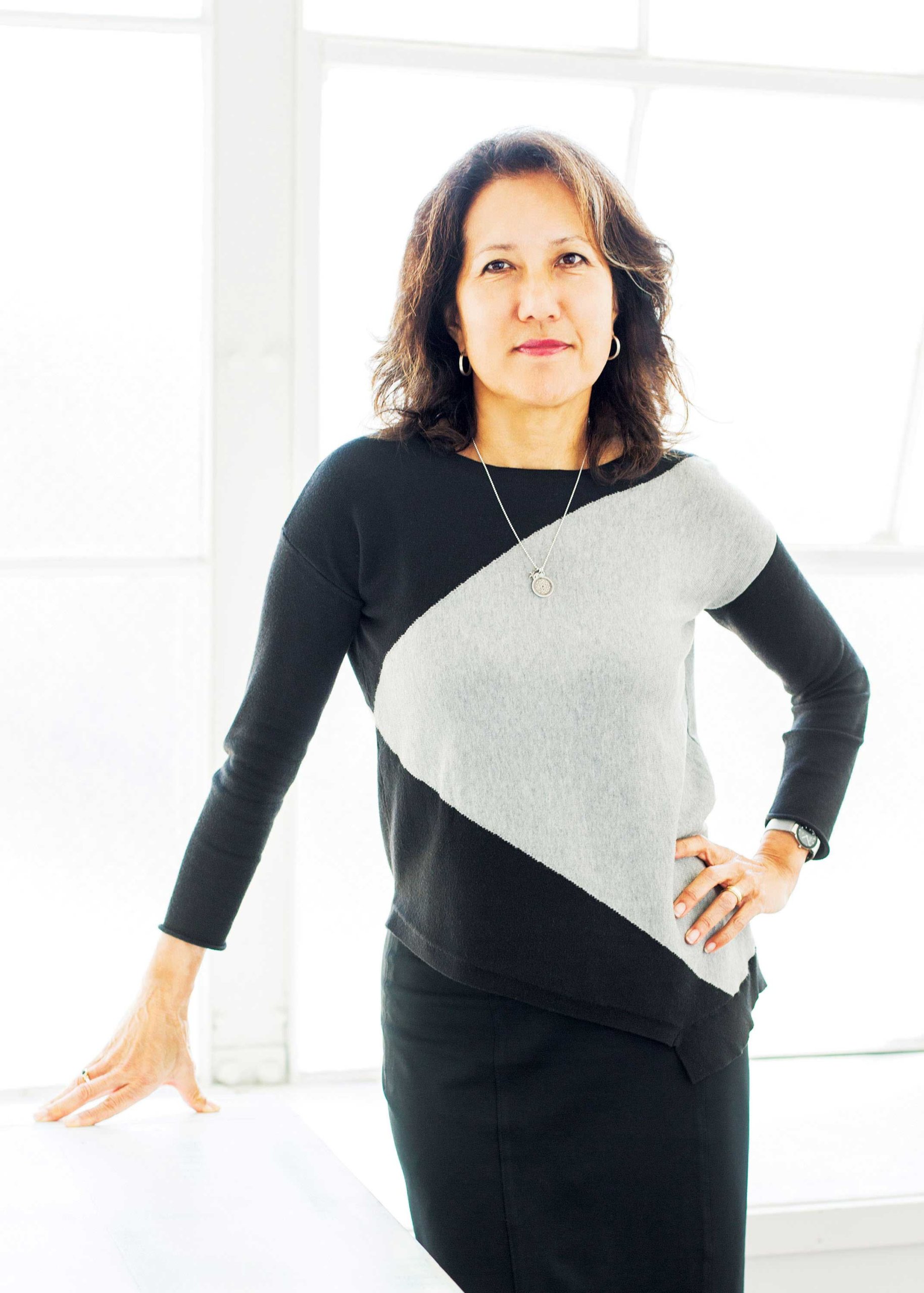
Paula Daniels ’73 is co-founder and founding chair of the Center for Good Food Purchasing, a nonprofit with a rating and evaluation system that recognizes the power of procurement to create a transparent and equitable food system, prioritizing the health and well-being of people, animals and the environment.
I founded the Center for Good Food Purchasing because I was interested in making a change in how our food system works. Did you know that one-third of greenhouse gas emissions come from our food system? And that just ten multinational companies control most of the food sold in the world?
We need to have our food purchases match our public policies about addressing climate change, protecting our land and water, and supporting our local economy. Food production affects all aspects of life – and it has an impact on our nutritional health. The way you purchase food, whether as an individual or an institution, makes an enormous impact on our society and our planet, so it is really worthwhile to make sure it’s pono.
Large-scale food service institutions, which buy in volume, send market signals throughout the food chain about the type of agriculture practices and food businesses they want to support. Through that, they can catalyze the marketplace to create long-term viability for local, environmentally sustainable and fair wage businesses.
We’ve seen it happen already. Within the first year of having our program adopted by the Los Angeles Unified School District in 2012, we saw immediate change. They went from less than 10 percent local sourcing of produce to an average of 60% local, which at that time meant $12 million redirected into the local food economy. Having a robust local food economy is also important for supply chain resilience in times of crisis, as we saw during the worst stages of the pandemic.
Our program now has traction in 60 institutions across 24 regions of the US, including Boston, Cincinnati, Denver, Chicago and New York City. In Hawai‘i, I am pleased to be working in partnership with the Mayor’s Office of Sustainability and Hawaii Public Health Institute on the Oahu Good Food Initiative.
Our team now includes current UC Berkeley graduate student and Punahou alum Kelsey Kamanani Conklin ’08, who is helping support an initiative called Transforming Hawai‘i’s Food System Together, led by UH West O‘ahu.
So much of my dedication to this work can be traced back to my childhood in Hawai‘i and at Punahou. My grandfather Harry Daniels (Kānaka Maoli from Maui) infused us with his recall of the ancestral wisdom, foremost being the philosophy of mālama ‘āina.
My mother, Jackie Young ’52, was a role model who became an elected official in Hawai‘i; she was ceaselessly committed to making the world a better place, with equal rights and dignity for all. Punahou was a wonderful place for developing a sense of possibility and creativity for me. I was encouraged to think big and to pursue my dreams. Punahou teaches you to believe in yourself, to know your own voice – so that you can add to the remarkable chorus of the world.
– By Paula Daniels ’73 and Tara Olney
Operation: Sustainability
Over the years, Punahou has taken bold steps to infuse sustainable practices throughout its massive campus operations. Some of the major undertakings include the installation of photovoltaic panels to generate solar power, cooling systems that use less electricity, the adoption of more efficient LED light bulbs and new charging stations for electric cars – but the job is far from over.
“Sustainability is a journey,” says Sunny Donenfeld, vice president and treasurer of Punahou. “We will never be able to declare that our efforts are officially done because we will always be striving for more.”
In addition to enhancing operational efficiencies, the School is exploring initiatives to promote greener lifestyles within the buff ’n blue community. Carpooling, water consumption and experimenting with AC temperature in classrooms and offices are under evaluation. The School is also looking at sustainable procurement practices when it comes to food and supplies.
“Sustainability is a major priority that needs to continue to be at the forefront of our strategic thinking and operations as a school,” says Noelehua Lyons ’91 Archambault, vice president for Institutional Advancement who – along with Donenfeld – co-chairs Punahou’s Infrastructure and Resources Working Group, one of the School’s key initiatives.
Punahou is delving deeply into the intersection between operational efficiencies and people’s energy consumption habits. “You need both,” says Charlotte Kamikawa, director of Physical Plant. “For years we have been working hard to strengthen sustainability on our campus. The technology is helping but we will also need the people component and the behavioral changes to make sustainability a lasting operational success.”
As Punahou marches forward with its sustainability goals, the School will continue adopting innovative technology and developing eco-conscious architecture. In fact, next year, the School plans to break ground on the Academy Learning Commons, a reimagining of Cooke Library that will be built to LEED-certified standards and is slated to open in 2025.
But people, and their energy consumption habits, will always be part of the School’s core strategy. “Throwing money at sustainability won’t get us to where we want to be,” says Donenfeld. “The more people understand the interconnections between our campus operations and the environment, the more they are empowered toward action and the type of changes that will make a difference – and a much stronger outcome.”
– By Gina Gelber
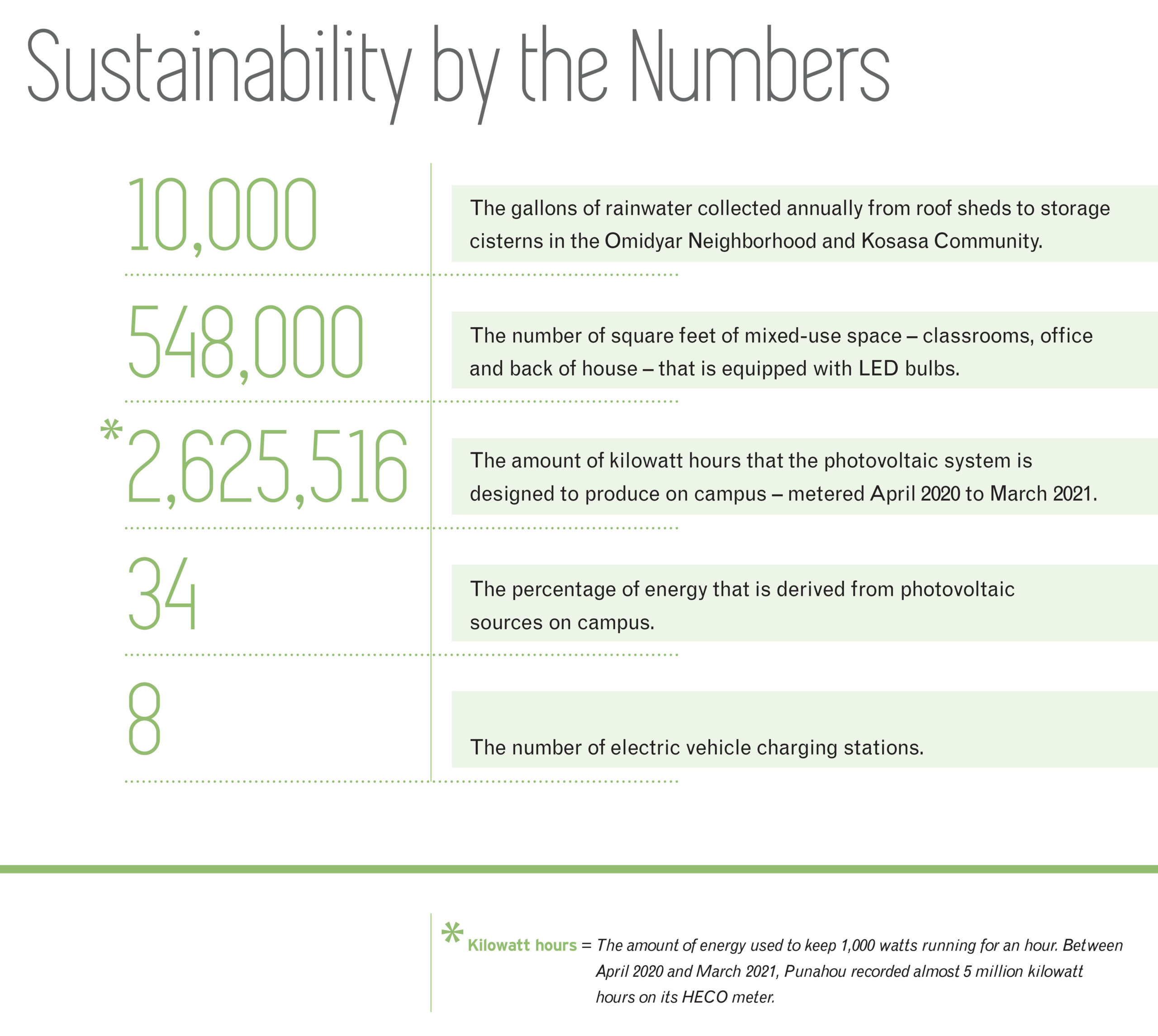
“For years we have been working hard to strengthen sustainability on our campus. The technology is helping but we will also need the people component and the behavioral changes to make sustainability a lasting operational success.”
Charlotte Kamikawa, director of physical plant
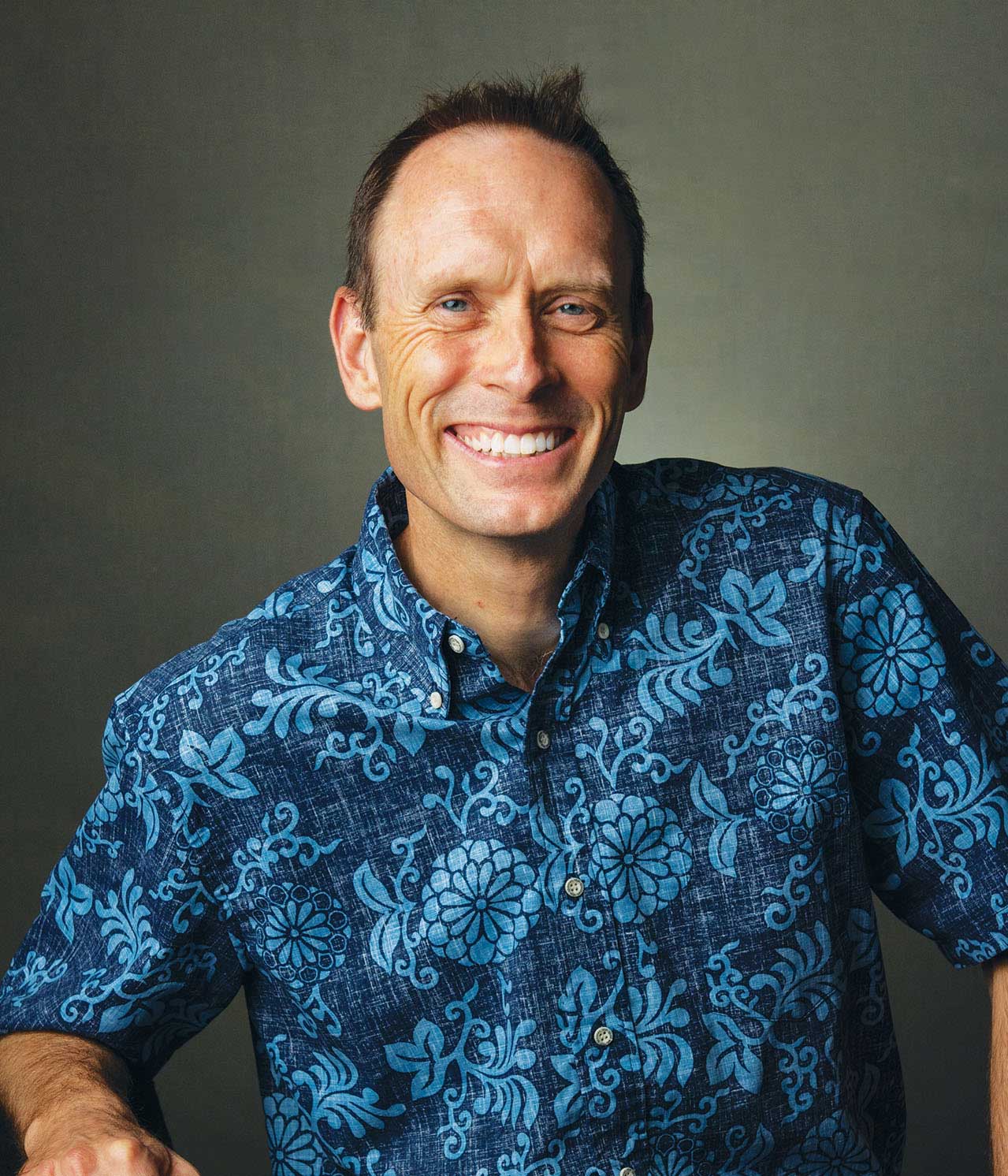
The Ripple Effect
This spring, President Latham announced plans to launch a sustainability initiative – one that builds upon the work that Punahou has undertaken in this space over the last two decades. A major element of this plan is to define goals and a strategy for sustainability education at Punahou from grades K – 12. In the Academy, Punahou also plans to develop a new program in partnership with other schools in Hawai‘i. The joint venture, for which Punahou will seek philanthropic support, will enable high schoolers from public and private schools across the state to collaborate on some of our most pressing environmental challenges.
Details of the program are still being worked out, but it will most certainly reach beyond the classroom and include field work, volunteer opportunities and internships so students can apply their knowledge to real world problems. At the end of their multi-year commitment, participating students can earn a certificate in sustainability that will live on their transcripts. Punahou is also embarking on an analysis of its own sustainability profile in terms of school operations, including energy consumption and conservation, food sourcing, water and waste.
To spearhead this initiative and oversee Punahou’s overall approach to sustainability, Latham also announced the School would hire a director of sustainability – an educator with extensive experience in environmental science and related fields who will ensure that the School continues to advance in sustainability, both in its curriculum and operations. “Sustainability is both an existential challenge for our society and an area of tremendous opportunity and innovation. Hawai‘i is an ideal laboratory for work in these areas, given our combination of geographic, scientific and cultural resources,” Latham explains. “As a school with a strong sense of community responsibility, we are eager to educate and empower students to define interests in this area and to determine how they can make enduring contributions.”
– By Gina Gelber

A Sense of Belonging
Sometimes, the answers to our existing problems can be found by looking at the past.
“The early Hawaiians understood the constraints of finite resources living on an island,” says Ke‘alohi Reppun ’99, director of the Kuaihelani Center for ‘Ike Hawai‘i. “They developed, out of necessity to survive, the concept of the ahupua‘a – a self-sustaining community of shared resources.” In many ways, the ahupua‘a mindset can help us to think about sustainability in the 21st century.
“It really has to be a way of life,” Reppun explains. “To achieve sustainability requires true behavioral change, long-term commitment and an honest assessment of what it will take to get there. We have a long way to go, but we have begun to take the first important steps.” Through ‘Ike Hawai‘i, Reppun hopes students develop a deep understanding of our common history and our common humanity, both of which she sees as essential for sustainability to endure.
“It is about having a sense of belonging,” says Reppun. While cutting-edge technology on campus is impressive, Reppun insists that human behavior and conviction are our most potent tools in creating a meaningful culture of sustainability. “We all share the same water, the same air, the same land – do we care enough about each other to take care of it? It is ultimately a question of community, and it begins with planting the seeds of sustainability with our students that will continue to grow.”
– By Gina Gelber
